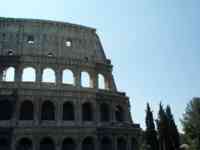
| Path: Eric's Site / Eric / Travel / Germany / Visits / Italy with Alex | Related: Germany, Journal, Visits (Site Map) |
The hotel was a bit outside the center of the city, but still quite accessible, and I knew that going in, from the Hotel Reservation Service's web server. Getting between the hotel and the city center required either two buses or a bus, a few blocks' walk, and the subway. Given that we only went from and to the hotel once a day, that 40-minute trip was fine.
Parts of Roma feel like New York except with Italian. (Of course, parts
of New York are like that too.) Italian looks a lot like a restaurant
menu. A big difference between Roma and New York is that Roma has only
two subway lines, which seems very few for such a large city. They need
more, because the public transit is very, very crowded.
 |
| Flavian Amphitheater. |
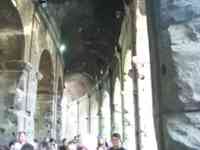 |
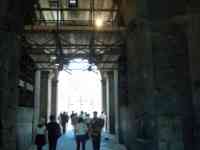 |
| Outer ring just after entering. | Entry into main part of amphitheater. |
Outside the amphitheater, tour companies solicit you to take guided tours.
While preparing for the trip, I read a recommendation to take a tour to
bypass the waiting line for tickets, so we paid for a guided tour.
 |
| Tourist dog. |
The right picture above is the emperor's entrance. There was a seat over the archway, but it is gone. In the large image, you can see a cross just beyond the arch. It was erected in memory of Christians killed in gladiatorial events. At the time, it may have been believed such events happened in the Flavian Amphitheater, but it is now believed such killings happened in other arenas but not the Flavian Amphitheater.
The dog in the picture appeared to be just another tourist, looking around.
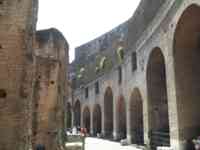 |
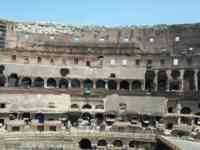 |
 |
| Inside the amphitheater. | Main seating area. Look at the people to get a sense of scale. | |
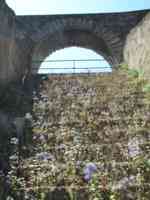 |
| Weeds. |
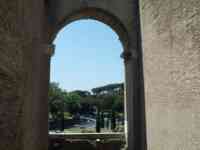 |
| View out from amphitheater. |
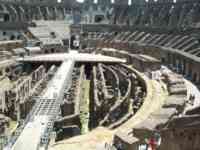 |
| Warrens underneath former wooden stage. |
The amphitheater might have been flooded to hold mock sea battles
(naumachiae). The warrens shown to the right may have been used
as animal dens or channels for water. There was a stage above them.
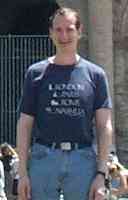 |
| Obligatory t-shirt in Roma. |
Outside the amphitheater are fast food trucks, from which we bought lunch.
I had a small pizza which was served folded in half. It was pretty good
for food from a truck.
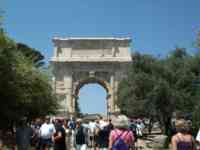 |
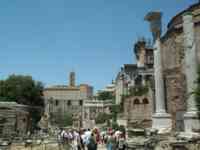 |
| Entry arch. | Roman Forum. |
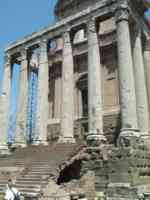 |
| A building in the Forum. |
 |
| Three columns. |
 |
| Roman Forum. |
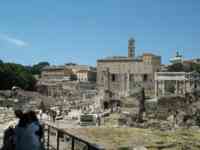 |
| Roman Forum. |
As Alex and I passed through, archeologists were digging in one building. It seems strange to be doing archeology in the middle of a large modern city. Have the ruins here not been picked over exhaustively by now?
I think the three columns to the right are the remains of
Tempio di Vespasiano. They look a bit precarious.
I wonder if anybody has estimated how much wind it would take to knock
them over. Entire buildings have collapsed here, so it must be only a
matter of time for these columns.
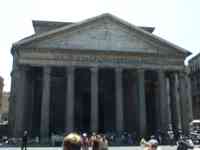 |
| Pantheon. |
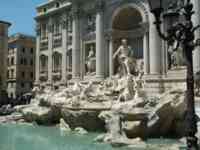 |
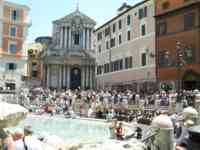 |
| Fontana di Trevi. | Spectators. |
Actually, before reaching those, it happened again. When I had been in Roma
less than five hours, somebody asked me for directions, to the Forum.
 |
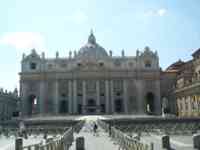 |
| Piazza San Pietro. | Basilica di San Pietro. |
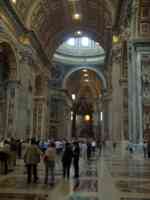 |
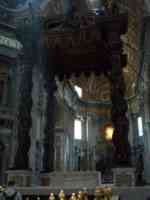 |
| Inside the basilica. | Baldacchino. |
While the Vatican snubs people, a sort of genial pants-exchange culture arises spontaneously. People on their way out of the basilica who bought or received disposable pants pass them on to others, free or for a small fee.
As I have mentioned before, I am not much impressed by large buildings and other monuments. Seeing the Vatican buildings makes me wonder how much good the church could have done if the wealth that went into the buildings, art, and artifacts had instead been used to educate people.
Unfortunately, we did not have the time or energy to visit the Sistine Chapel or the Vatican Museums. We left the Vatican and found dinner and worked on other errands in the city. I wanted to get another shot glass from the Hard Rock Cafe for Cathleen's collection, but they were out of stock. The store said they ran out yesterday and would have more tomorrow. Returning the next day would be difficult, since we would be in Pompei and Napoli most of the day.
In the evening, we headed for the Trastevere area to find a gelateria Simone recommended.
Here are some observations I made while traveling the city. As I mentioned before, the buses and trains are often very crowded. The subway cars are completely covered with graffiti. In buses and subways, it is common for people to move to the exit while the vehicle is at the stop prior to the one at which they wish to get out. They do not just move to the exit as the vehicle approaches their stop, as people do in other cities; they do it earlier, during the preceding stop. Alex noticed the speed of the escalator handrails in the subway stations is faster than the speed of the steps, by about one step width per flight.
There are lots of motor scooters in Italy, and traffic is chaotic. There are special lanes that look to me like they are for buses, and I suppose the taxis may be permitted to use them too, but I suspect the scooters zipping through them are cheating. Especially the ones going the wrong way.
Crossing the street in Roma is very mathematical. To get across the street at a crosswalk, it is of course sufficient that the cars stop for you. You must prove to the drivers that it is necessary they stop. You can provide a demonstration of this theorem by walking in front of them. The drivers will conjecture that they can get around you and will approach as closely as they desire.
After navigating Roma, we found the gelateria (Fonte della Salute at
Via Cardinale Marmaggi 2-6). I had cioccolata, fico, and
cacao. The gelato was better than some ice creams, but I
am spoiled by the ice cream I make with a recipe modified from
Death
by Chocolate. It has just four ingredients: chocolate, heavy
cream, sugar, and egg yolks.
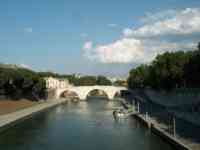 |
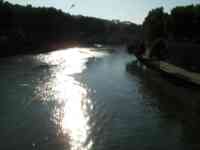 |
| Fiume Tevere (Tiber River). | |
We continued north on the the #8 streetcar, got off at the end
of the line, and started to cross the street, but a police officer stopped
traffic, and the pope drove by. Well, he wasn't driving personally, just
riding in a motorcade. It was a simple transport motorcade, not a
display procession, so I think he was just out grocery shopping or
something. The pope passed within about five meters of me, which is a
pretty rare opportunity for him. (Me, I did not even notice it was the
pope. Alex told me he saw the pope in one of the vehicles.)
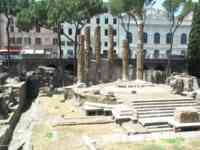 |
 |
| Argentina Plaza. | Resident cat. |
 |
| Flavian Amphitheater. |
One more thing I would have liked to see in Roma is Domus Aurea,
Nero's "Golden House." From Fodor's: "After fire destroyed much of
the city in AD 64, Nero took advantage of the resulting open space to
construct a lavish palace so large that contemporary accounts complained,
'All Rome has become a villa.'" One wing of the Domus Aurea is a new
ruin; it just collapsed in 2000.
To get to Scavi di Pompei
(Ruins of Pompeii), we took the bus
from the hotel, walked to the Metro, rode to the central train station,
took a train to Napoli, bought tickets for the Circumvesuviana train,
waited at the platform for the train to Sorrento, and rode to the
Pompei—Villa dei Misteri stop.
Samuel Clemens walked these streets and wrote about them as Mark Twain
in Innocents
Abroad. You can find a good description of the eruption in the year 79
in this web page,
[link broken]
which also says that Mount Vesuvius
erupted as recently as 1944.
A NASA web page [link broken]
says Pompei was buried under "several meters" of debris, and another source
says six meters. But the tallest buildings are ten meters high, and there
are large changes in ground level, so it is not clear to me how Pompei
could have been lost for so long.
I will let the photographs tell most of the story of our Pompei visit.
I hope the diversity in the scenes gives you some idea of the extent of
the city.
Fodor's says there is a graffito at the baths saying, "What is the use of having a Venus if she's made of marble?", but I did not find it.
In one area of the ruins, portions of the original sidewalk are still present—little colored stones in one place, little red stones in another. Similar patterns appeared at Villa dei Misteri, and I took photographs to use as web-page backgrounds.
 |
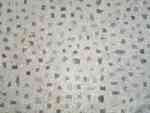 |
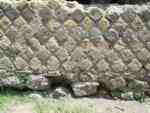 |
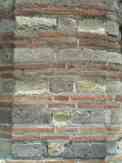 |
| Various tilings found around Pompei. | |||
I would have liked to see more information at Pompei. What is original, what is reconstructed, and what is speculated? I saw wooden beams embedded in stone, so I suppose they are original. Street names are posted, but I do not know if they are original or modern labels.
The gift/souvenir shop had some books about Pompei, including one with photographs of Pompei sites and transparent overlays showing what the buildings might have looked like in use. However, the shop did not have an English version. Outside the ruins, I found an English version at a stand. The book is Pompeii, Herculaneum, Villa Jovis on Capri: Guide to the Excavations with Reconstruction Transparencies, published by Editrice Millenium and Lozzi Roma reconstruction and drawings by Andrea Tosolini, text by Maria Antonietta Lozzi Bonaventura. The book appears to be a well written serious work—aimed at a popular audience but not just tourist fluff. It answers some of my questions. Some information from the book is:
In the House of the Vettii, many bronze and marble fountain statues have been left in place, ancient lead pipes have been put back into operation, and the design of the flower beds has been reconstructed from the holes left by the roots of the plants.
Among the finds are 81 carbonized loaves of bread. That puts the single century-old loaf at Hohenschwangau Castle to shame.
Pompei suffered an earthquake in the year 62 (Hint: If you live near a known volcano and there is an earthquake, it is time to move), and some of the buildings have been found incomplete not because they were damaged in the eruption but because they were being reconstructed after the earthquake. In some cases, construction materials ready for use were found near the buildings.
From Pompei, we went back to Napoli.
The good thing about Napoli was that it was easy to transfer to the train to Pompei. Otherwise, Napoli is not a tourist-friendly city. The tourist information center in the train station is not visible as you walk the main route out of the station, although we found it later, as we were leaving the city. The city has few or no signs in English, and few or poor English speakers in roles where you would expect language skills, like transit information booths. Of course, there is nothing wrong with that if you do not want tourist euros.
However, from what I saw, Napoli is not even friendly toward its own
citizens—transit maps were not well posted, and fare information
was not readily apparent. Traffic is insane, worse than Roma. The roads
are congested and noisy. There are no benches at bus stops. We tried to get
a good view of the gulf but found all accesses we tried closed off by gates.
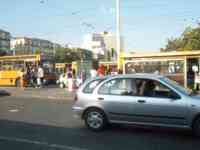 |
| First bus stop seen from second. |
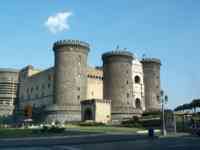 |
| Palazzo Reale. |
 |
| Golfo di Napoli. |
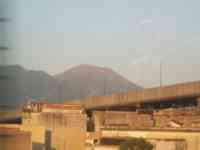 |
| Mount Vesuvius. |
I took this photograph of Mount Vesuvius on the train out of Napoli.
Here is another general Italy observation: Italy has not rounded prices after
the euro conversion as much as Germany has. For example, single-trip transit
tickets are €0.77 in Napoli and Roma. Germany has rounded more things
to multiples of ten cents or whole euros.
Termini seems to allow smoking in the main room, where people wait and watch the display board for their train to be shown, and to allow smoking on the tracks, where people wait to board.
The seats on the train were numbered in a strange arrangement:
Our ride to Venezia took over five hours. It started ten minutes late and ended 50 minutes late. Essentially all of our trains in Italy were late.
Window 76 74 Aisle 78 72 Window 75 77 73 71
 |
 |
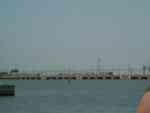 |
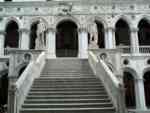 |
| Grande Canal. First views of Venezia, from Ponte degli Scalzi near the train station. | Train crossing causeway to Venezia. | Steps in Palazzo Ducale. Doges were crowned here. | |
Your first few minutes in Venezia are spent confirming with your own eyes that Venezia is indeed a city in the water. Yes, the depictions you have seen are real. It also seemed to me that Venezia has an old Italian feeling, more so than Roma. I cannot say whether that is because the character is preserved for tourists or because it is hard to build anything modern in a crowded marsh. Of course, Roma also suffers from the anonymous character that all big cities acquire to some degree, in spite of its unique antiquity and history.
We took an express vaporetto to the hub of activity, Piazza San Marco, and started with the museums in the Doge's Palace. The far right photograph above shows the steps where the new doge was crowned, and the far left photograph below shows the palace courtyard. The museums charge too much (€11) and do not allow photographs. So I cannot show you the view from the Ponte dei Sospiri (Bridge of Sighs) that leads to the prisons, let alone the meeting rooms or art in the palace, which includes the world's largest oil painting, Paradise, 23 feet by 75 feet.
My new policy is to avoid museums that prohibit photographs. Prohibiting
flashes to preserve paintings is okay, but cultural institutions should
proliferate knowledge, not restrict it.
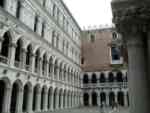 |
 |
 |
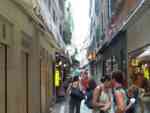 |
| Courtyard in Palazzo Ducale. | Glass aquarium in Pauly. | Piazza San Marco. | A busy calle (street). Streets can be narrow since they need not fit vehicles. |
Next we explored the Piazza. Alex looked for Venetian glass for Mom, and I had my eye on the small aquarium above. However, for €245, I will skip it. We ate at a café bordering the Piazza, and my pesto pasta was very good.
Venezia is swarming with tourists. Sure, there are lots of tourists
in Paris and Roma, but there are at least some residents among the
crowds in those cities. Venezia looks like it is almost all tourists
and tourist-industry workers.
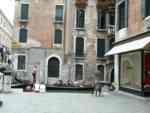 |
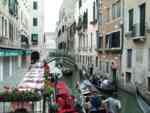 |
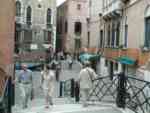 |
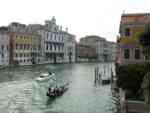 |
| Gondola at end of street. | Gondolas. | Walkways and bridges. | Grande Canal. |
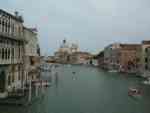 |
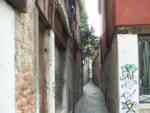 |
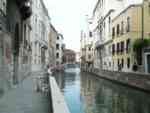 |
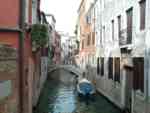 |
| Grande Canal. | Empty calle (street). | Canal and riva (sidewalk by canal). | Canal. |
After eating, we tracked through some back roads to find a mask shop where Alex wanted to look for a mask for a friend. The pictures above were taken along the route. I picked up a pastry along the way, and it was very good. I wish we had had more time to eat in Italy.
While we were looking for the mask shop, we passed a police officer, and I wanted to ask for directions. Several souvenir stands were selling Hard Rock Cafe shirts, and, if there was a Hard Rock Cafe in town, I wanted to get a shot glass for Cathleen. After all the times I have been asked for directions in foreign countries, it was finally my turn to ask, and I asked somebody who ought to know his way around. Nope, the police officer had been in town only two days and did not know if there was a Hard Rock Cafe around. (Sorry, Cathleen, there isn't. The shirts were likely unauthorized.)
It would have been nice to get a mask of Galileo in Venezia. I asked at
the mask shop if they had one. They didn't.
 |
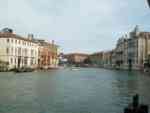 |
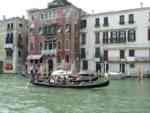 |
 |
| Fruit and vegetable boat. | Grande Canal and Ponte dell'Accademia. | Gondolas on Grande Canal. | Islands. |
The Campanile is a belltower in Piazza San Marco with
an elevator. The owners make a fortune charging €6 per person for a
ride to the viewing area. The right photograph above and the four just
below were taken from the tower. They may give you some sense of how large
the city is.
Vendors in the Piazza sell food for the birds. When you buy a package and open it, pigeons flock to you, as seen above.
As the day ended, we wandered back and forth in Venezia. Alex wanted to find a toilet. There is a pay toilet near the docks at Piazza di San Marco, but it closed in the evening, even with plenty of potential customers still around. Europeans really do everything on a different schedule.
Our train left the city at 10:43 p.m., so we got to see Venezia at night
before leaving.
 |
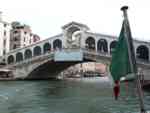 |
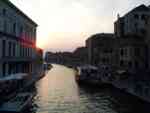 |
 |
| A hotel. | Ponte di Rialto. | Venezia in the evening. | Venezia at night. |
I left Venezia not knowing how they build there, what they do for foundations, how they get construction equipment into the city, or what they do for plumbing for fresh water and for sewage.
None of my pictures show the vaporetti or their docks well. To catch
a vaporetto, you wait on one of the floating docks, rocking a little,
until a boat comes along and bangs into it. Then you ride around the city
for a while. It takes 30 minutes or more to get from the train station on
the north side to Piazza San Marco on the south side. That is a fine
ride for your initial trip, when you are sightseeing and taking pictures,
but it is slow when you want to get somewhere.
We arrived early in the morning, stored our bags at the hotel, used their bathroom to freshen up, and walked to the Deutsches Museum.
The model train exhibit was a bit disappointing to me. It was just a single set
that you could see only from a distance, along with display cases of
isolated cars. Otherwise, the Deutsches Museum was pretty good, although
not as good as the Science Museum in London. Some areas, such as the
electric power section, had only labels in English, not entire explanatory
signs, but most parts of the museum had a good deal of English.
| Model of a silicon crystal. |
 |
| Radio telescope, rescue cruiser, windmill. |
 |
| Model or toy trains. |
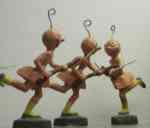 |
| Toy martians. |
We spent a little more time in Marienplatz, but most stores were closed. Alex found a shop with beer steins that was sort of open. Then we went back to the hotel, moved our luggage to a room, and caught up on sleep missed on the train.
Eventually we went back to the Hauptbahnhof and tried to find a Straßenbahn to go to Nymphenburg. This was an ordeal, because construction had interrupted Straßenbahn service, and the street map was not clear on the normal route anyway. A bus replaced part of the Straßenbahn route, but it was slow in coming, so we walked to where the Straßenbahn was running.
Nymphenburg was the former seat of government and residence of the
Wittelsbach dynasty. It was almost entirely destroyed in 1944, and
the buildings there now are reconstructions. Approaching Nymphenburg,
the buildings looked to me larger than Versailles.
 |
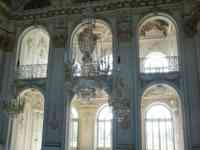 |
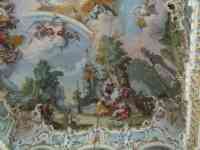 |
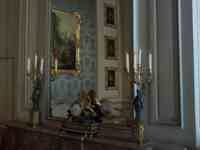 |
| Nymphenburg buildings. | Chandeliers. | Ceiling. | Residential room. |
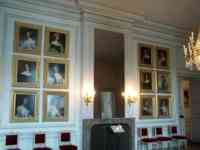 |
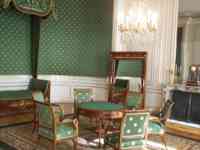 |
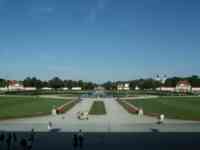 |
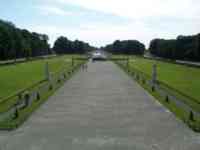 |
| Schönheitengalerie. | Game room. | Front yard. | Back yard. |
 |
 |
| Part of park. | Rear of Nymphenburg. |
We took the U-Bahn back to the Hauptbahnhof, had dinner, and called it a day.
I do not care what the sign at the stand in the Hauptbahnhof says,
the pizza with the corn on it is not "American pizza."
| Path: Eric's Site / Eric / Travel / Germany / Visits / Italy with Alex | Related: Germany, Journal, Visits (Site Map) |
© Copyright 2003 by Eric Postpischil.